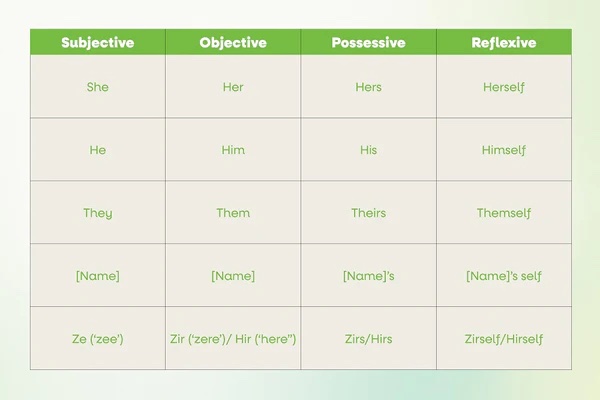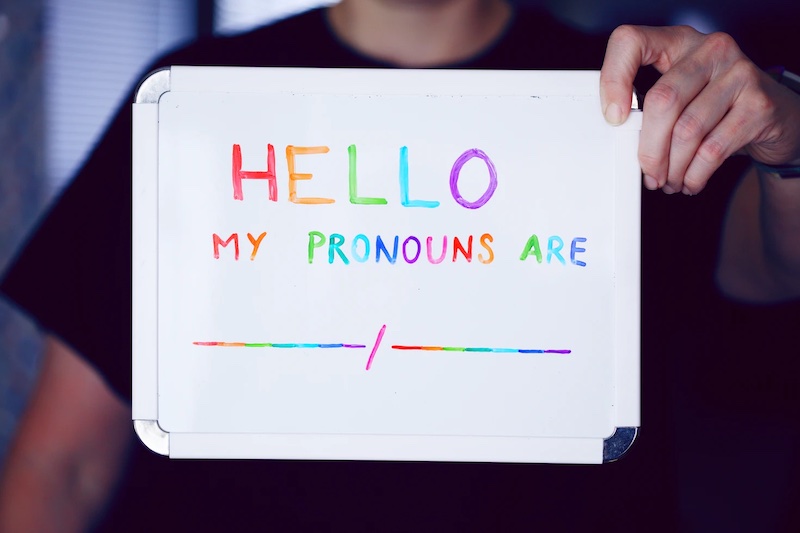What do pronouns mean to you? Do you notice them? Are you worried about using the right ones when referring to friends, acquaintances, or even yourself? When gender expression does not match the social norms, pronouns are there to help us be more respectful by adjusting our language. Here’s a great article on the topic from Good Clean Love.
An Intro to Gender Pronouns: How to Recognize and Respect Someone’s Identity
Our cultural conceptualization of gender as a society is changing. Most of us are aware of the rise in the use of gender-neutral pronouns, as the cultural visibility of others who do not feel identified within the gender binary has increased in recent years. About 1.6% of U.S. adults are transgender or nonbinary, with that number jumping to 5% when looking only at adults under 30. However, many of us may not understand what gender neutral pronouns are and why they are crucial to many.
Since it is becoming more common for people to use gender neutral pronouns, how can those of us who are not familiar with this cultural shift be accommodating and considerate of others’ identities? Let’s explore what personal pronouns are and why people are choosing to share them.
The Basics of Sex and Gender
So, how is it that our cultural conceptualization of gender may be expanding? Many of us view gender and sex as the same thing, but distinguishing the two from each other may make this cultural shift more understandable. Historically, these terms have been used interchangeably, but they mean different things.
Sex (assigned sex/biological sex) is the label one is assigned at birth based on physical and physiological characteristics such as genitals, hormones, chromosomes, and anatomy. Sex is usually categorized as female or male but there is variation in the biological attributes that comprise sex. Instead of saying sex, some refer to this as “assigned male at birth” or “assigned female at birth.” The assignment of biological sex may or may not align with how a person feels or identifies. It’s important to know that male and female are not the only sexes that can be assigned at birth. Other arrangements of chromosomes, hormones, and body parts can happen, which results in someone being intersex.
Gender is more complex and made up of a variety of socially constructed norms, expressions, and roles attributed to girls, women, boys, men, and gender-diverse people. According to sociologists Candace West and Don Zimmerman, “Gender is not something we are born with, and not something we have, but something we do.” We are all aware of gender roles, which are societal expectations typically associated with either masculinity (for men) or femininity (for women).
Many of us were raised with the expectations of aligning with the gender norms associated with our biological sex. For example, there are ideas about how men and women should dress and behave according to popular gender norms. Gender does not have to be associated with male or female; since it is socially constructed, people can define what gender means to them and their identity. In fact, gender nonconformity is nothing new – it has been prevalent in many cultures throughout history. And many of those cultures have terms for gender-nonconforming people that have been used for centuries.
In short, sex is a biological trait based on reproductive potential and physiological characteristics, while gender is the social elaboration and constructions usually associated with biological sex.
Those of us who identify with the sex we were assigned at birth are cis-gender, while those who don’t identify with the sex we were assigned at birth are transgender or genderqueer. These terms are not the be-all-end-all, as there are many different labels someone may choose to identify with, but they are popular umbrella terms. Cis-gender people identify with one of the two identities in the gender binary, male or female. People who identify as queer, trans, non-binary, agender, or genderfluid do not feel that their gender identity aligns with the historically traditional gender binary of males and females. But what is gender identity?

Gender identity is an individual’s internal sense of their gender, regardless of the sex assigned to them at birth. According to Mia Fine, a guest on Dear Sex Podcast, “Gender identity is a person’s sense of self in relation to gender.” Therefore, it is how one perceives their gender, how they wish to express this identity, and what language they choose to use in claiming their identity. The pronouns that someone chooses to identify with can solidify their gender identity and present how they would like to be referred.
Many typically associate gender identity with sexual identity or orientation, but it’s important to keep in mind that these are two different concepts. Sexual identity is how one identifies who they are sexually attracted to, while gender identity is how one identifies their own sense of gender.
Pronouns: Another Layer of Identity
An important thing to understand when discussing pronouns is that we can’t always know someone’s pronouns or gender identity just by looking at them or interacting with them. According to Mia Fine, “The important piece [to consider] here is how the person in front of you defines how they identify,” and to try not to immediately assume that everyone else adheres to the gender binary and traditional understanding of gender as either male or female.
Sharing pronouns is a way for genderqueer people to express their gender identity and state how they wish to be acknowledged. Someone who is transitioning into embracing their identity as genderqueer may share their pronouns or change their name as part of adopting a new public gender identity that is more congruent with the way they genuinely identify. This process can be scary, so it is important to use language that makes people feel supported during their transition. This can help them feel validated in their identity and supported by those who surround them.
People who do not identify as cis-gender may feel compelled to share their correct pronouns to express themselves authentically and be truly seen/known by the people in their life in the way they wish to be. How genderqueer and genderfluid people want others to show up for them will depend on the person, like anything else that has to do with identity. If you know a genderqueer person in your life and they share their pronouns with you, ask them how you can best support them! Every answer from each individual may be different, so it’s important not to assume. Although, one of the best ways you can support them is by making a genuine effort to refer to them by their correct pronouns.
Breaking Down Pronouns
Here is a quick overview of the most common gender pronouns and how to use them. This is not the be-all-end-all list of pronouns, but these are the most commonly used pronouns.

Showing You Care: Pronoun Etiquette
So, what do you do when someone shares their pronouns with you? When someone shares their pronouns with you, they communicate how they would like to be referred. By respecting someone’s pronouns and using them in conversation, you respect them and support them in their identity. Of course, it is okay to make mistakes. We all slip up from time to time. If you make a mistake when referring to someone’s pronouns, it is best to correct yourself, provide a brief apology, and move on. For example, “I think she, I mean they, are over there.”
Try your best to call someone by the pronouns they have shared. Some people choose to refer to those they do not know the pronouns of as they/them, rather than assuming the gender of a stranger or acquaintance.
The more you do this, the more of a habit it will become and the easier it will get. It is also fine to ask someone what their pronouns are, and sharing your pronouns first can create a safe space for another person to share theirs. For example, “My name is Sara and I go by ‘she, her, hers pronouns. What are your pronouns?”
Suggested Dos and Don’ts
To sum everything up, here are some tips and best practices when it comes to respecting gender pronouns.
Do
- Feel free to share your pronouns with others, no matter how you identify. This can make someone who is genderfluid feel more comfortable in sharing their pronouns.
- Respect another person’s pronouns and do your best to refer to them using their correct pronouns.
- Consider referring to those you don’t know as they/them, rather than assuming their gender identity.
- Educate yourself on issues that are important to the transgender and gender non-conforming community.
- Be open to discussions about gender, how it affects situations in your life, and the lives of people around you.
- Challenge transphobia and harmful gender assumptions.
Don’t
- Question another person’s pronouns.
- Purposely use the wrong pronouns for someone.
- Ask genderqueer individuals invasive questions about their genitalia or lifestyle.
- Assume an individual’s gender identity before you know them.
Conclusion
The most important thing about acknowledging another person’s correct pronouns is being respectful of them as a human being who can shape their own identity and deserves to be seen and respected.
To see the original article on the Good Clean Love site, click here. For any help you might want or questions you might have, feel free to contact me!

